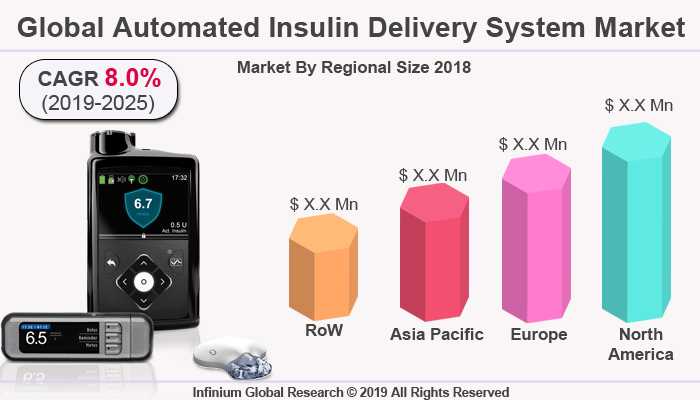Automated Insulin Delivery System Market (Disease Type - Type I Diabetes, and Type II Diabetes; End User - Hospital Pharmacies, Retail Pharmacies, and Diabetes Clinics): Global Industry Analysis, Trends, Size, Share and Forecasts to 2025
A recent report published by Infinium Global Research on
automated insulin delivery system market provides in-depth analysis of segments
and sub-segments in the global as well as regional automated insulin delivery
system market. The study also highlights the impact of drivers, restraints, and
macro indicators on the global and regional automated insulin delivery system
market over the short term as well as long term. The report is a comprehensive
presentation of trends, forecast and dollar values of global automated insulin
delivery system market. According to the report, the global automated insulin
delivery system market is projected to grow at a CAGR of 8.0% over the forecast
period of 2019-2025.
Market Insight
Automated insulin delivery is also known as a hybrid closed
loop, artificial pancreas, bionic pancreas, and predictive low glucose
suspend. The objective of an automated insulin delivery system is using
continuous glucose monitors (CGMs) and smart algorithms that automatically
decide and adjust insulin delivery via a pump. The aim of this product is to
reduce/eradicate hypoglycemia, remove user input from insulin dosing, improve
time-in-range, and reduce hyperglycemia. Insulin is the hormone that notifies
the cells to take sugar from the blood and utilize it as an energy source. In
type 1 diabetes, the immune system destroys beta cells in the pancreas, which
makes insulin. In the absence of insulin, there is an escalation in blood sugar
levels, resulting in a diabetic coma, and the body burns fat stores and muscle
for energy. Thus, in order to maintain blood sugar levels in people with type 1
diabetes, it is necessary to monitor their blood sugar throughout the day
continuously. The automated insulin delivery system relies on a transmitter
which is attached to a tiny needle inserted into the skin that continuously
tracks glucose levels, a pump that delivers accurate doses of insulin as they
are required via a separate catheter inserted into the skin, and a computer
chip that uses data from both to upgrade the delivery of insulin. The automated
insulin delivery system allows people with type 1 diabetes significant freedom
to live their lives without having to manually and constantly monitor baseline
glucose levels and deliver insulin.
The rising prevalence of diabetes worldwide is the major
growth factor for the automated insulin delivery system market. According to
WHO reports the number of a diabetic patient has increased from 108 million in
1980 to 422 million in 2014, these rising numbers are augmenting the demand for
advanced insulin delivery systems for the hassle-free insulin uptake. Moreover
increasing research and development activities for the production of innovative
insulin delivery systems and increasing awareness campaigns by various
companies are further boosting the growth of the market. However, technology
snags may limit the adoption of an automated insulin delivery system.
Difficulties with the calibration of a glucose sensor, sensor durability, skin
related issues can restrict the use of an automated insulin delivery system. On
the other hand, lenient regulatory approval and technical clarity for the use
of devices among people can provide a better opportunity for the growth of the
market.
Region wise automated insulin delivery system market
segmented into North America, Europe, Asia Pacific and Rest of the World.
Currently, North America holds the top position in the automated insulin
delivery system market. The presence of top manufacturers and large investment
in R&D for upgradation of existing insulin pumps and new product
development are contributing to the growth of this region. European market
expected to grow with a steady rate in the forecast year. In the near future
developing countries in Asia-Pacific like India, China and Japan expected to
grow with a high CAGR. Large diabetic patient pool and heavy investment in the
healthcare sector are fuelling the growth of the market.

Segment Covered
The report on global automated insulin delivery system
market covers segments such as disease type, and end user. On the basis of
disease type, the sub-markets include type I diabetes, and type II diabetes. On
the basis of end user, the sub-markets include hospital pharmacies, retail
pharmacies, and diabetes clinics.
Companies Profiled:
The report provides profiles of the companies in the market
such as Medtronic plc, Eli Lilly and Company, Tandem Diabetes Care, Inc.,
Insulet Corporation, Bigfoot Biomedical, Inc., and Other companies.
Report Highlights:
The report provides deep insights into the demand forecasts,
market trends, and micro and macro indicators. In addition, this report
provides insights into the factors that are driving and restraining the growth
in this market. Moreover, The IGR-Growth Matrix analysis given in the report
brings an insight into the investment areas that existing or new market players
can consider. The report provides insights into the market using analytical
tools such as Porter's five forces analysis and DRO analysis of automated
insulin delivery system market. Moreover, the study highlights current market
trends and provides forecast from 2019-2025. We also have highlighted future
trends in the market that will affect the demand during the forecast period.
Moreover, the competitive analysis given in each regional market brings an
insight into the market share of the leading players.
